War and medical development
War leaves devastation, destruction and loss in its wake. However, war can also bring about medical advancements at a greater pace as medical pioneers race to save as many soldiers and civilians as they can.
So, what impacts did World War One and World War Two have on medical developments during the 20th century?
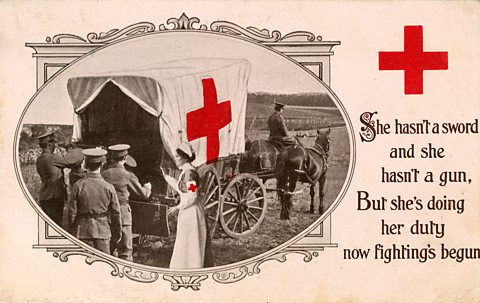 Image source, ALAMY
Image source, ALAMYBattlefield injuries during WW1
Fighting in World War One resulted in high numbers of casualties on all sides:
- More powerful automatic weapons could cause more damage and deeper injuries to more people.
- The large number of casualties made it difficult to treat injured people quickly.
- Overcrowding and poor hygiene in the trenches led to soldiers suffering from dysenteryAn infection of the intestines that causes diarrhoea, stomach cramps and vomiting., and encouraged lice which spread trench fever.
- Living in damp or flooded trenches could cause trench foot. Severe cases could lead to gangrene.
- Fighting in dirty, muddy conditions exposed wounds to bacteria which caused infection.
- Intense fighting and ongoing bombing had a terrible psychological impact, causing shell shock
Loss of limbs during WW1
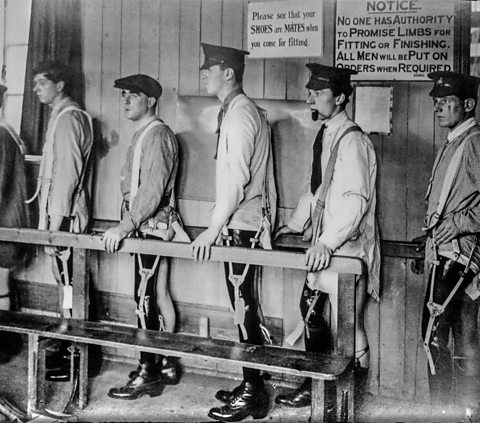 Image source, ALAMY
Image source, ALAMYWhilst fighting in Europe during World War One, many British troops sustained injuries to their limbs.
Due to the scale of medical need at the battlefields, there was little time for medics to try and save injured limbs. Many men had damaged arms and legs amputated - by the end of the war over 40,000 soldiers had lost a limb.
At first, Britain was not prepared for the numbers of amputees it was receiving from the Front and it had to turn to America for assistance.
As a result of the American Civil War (1861-1865), American companies were better equipped to meet the demands Britain faced. Some even made the journey across the Atlantic to help set up factories which could manufacture artificial limbs.
This led to an expansion of rehabilitation centres and the design and increased production of prosthetic limbs.
Queen Maryâs Hospital in Roehampton was established as a specialist centre to help soldiers adjust to life with a prosthetic limb and provided them with the opportunity to participate in exercises that were designed to help them re-enter society after the war.
Throughout the war, surgeons like Thomas Openshaw designed prosthetic limbs for British soldiers whilst he worked at Queen Maryâs Hospital.
 Image source, ALAMY
Image source, ALAMYFacial injuries during WW1
Many soldiers returned to Britain from the war with facial injuries.
As a result, Saint Maryâs Hospital in Sidcup was established by Sir Harold Gillies to try and help them.
Gillies would take Skin graftA skin graft is a medical process where a section of healthy skin is removed and used to cover an area of damaged or missing skin elsewhere on the body. from undamaged parts of the patientâs body and use these to mask the injuries sustained during the war.
At the time, the process was a medical innovation and allowed many injured airmen the opportunity to live within society again.
Not all of these soldiers felt able to re-join society, however. Some patients with serious disfigurement chose to remain at the hospital where they worked in isolation for the rest of their lives.
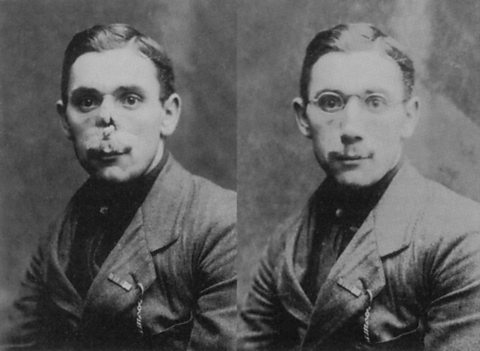 Image source, ALAMY
Image source, ALAMYWhilst working as an orderly at Londonâs Third General Hospital in 1916, sculptor Francis Derwent Wood used his artistic skills to help soldiers returning from war with facial injuries which could not be repaired by surgery.
Wood created a lightweight prosthetic metal mask to exactly fit each patient. Onto this he painted as close as possible a depiction of the patientâs original features, often using pre-war photographs for reference.
Patients complained the masks were hot and itchy and many discarded them after only a short time. Even so, it gave men with the very worst facial disfigurements a way to re-enter society and to try to return to their old lives.
Similar work was undertaken in Paris by American sculptor Anna Coleman Ladd. She and her team created 185 masks by the end of 1919.
 Image source, ALAMY
Image source, ALAMYPsychological issues from war
Many soldiers suffered from a condition known as shell shock â now we refer to this as Post-traumatic stress disorderPost-traumatic stress disorder is a mental health condition where people relive traumatic incidents from earlier in their lives..
During World War One, many of the men who were admitted to hospital suffering shell shock were never able to return to military duty. With so many soldiers killed or injured, military leaders wanted these men well enough to return to the trenches. As a result, the government established rehabilitation hospitals for those suffering from shell shock.
In the early years of the war, shell shock was believed to be caused by physical injury to the nerves. Treatment included massage, rest, strict diet and electric shock treatment. Later, medical officers began treating shell shock as a psychological condition, treated with the 'talking cureA treatment for mental health conditions, based on talking through issues with a therapist or counsellor.', hypnosis and rest.
WW1 war poets
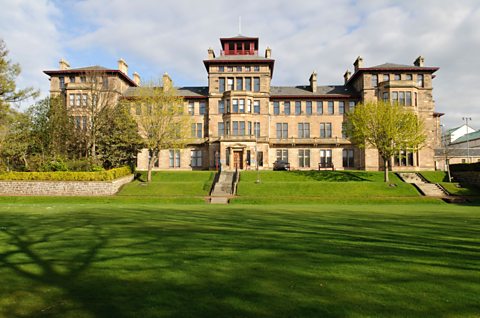 Image source, ALAMY
Image source, ALAMYOne of the most famous rehabilitation hospitals was at Craiglockhart War Hospital in Edinburgh.
Between October 1916 and March 1919, 1736 patients were treated at Craiglockhart. Of these, 758 were returned to duty after their treatments.
It was at Craiglockhart that the two famous World War One poets Wilfred Owen and Siegfried Sassoon met in 1917. Both men were treated for shell shock and both returned to the trenches. Sassoon survived being shot in the head and spent the end of the war in Britain. Owen was killed in action on 4th November 1918, one week before the war ended.
 Image source, ALAMY
Image source, ALAMYCowardice or illness?
306 soldiers from Britain and the Commonwealth were court martialled and executed for military offences including desertion or cowardice during the Great War.
Those shot were seen to have brought such shame on their country that their names were not listed on official war memorials.
Many of these men's families argued that they were suffering from shell shock and campaigned to have their names cleared. In 2006, all these soldiers were formally pardoned.
Treating infection
Alexander Fleming
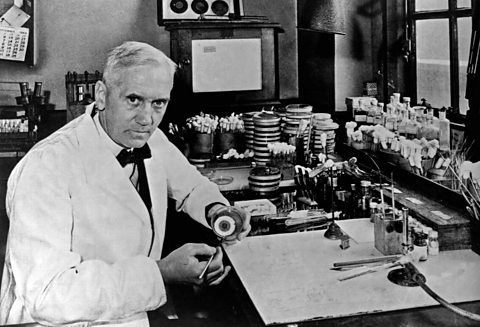 Image source, ALAMY
Image source, ALAMYIn 1928, the Scottish biologist, Alexander Fleming took a holiday from his laboratory. He left behind a petri dish containing bacteria, which he planned to deal with on his return.
When Fleming returned he discovered that mould had accidentally got into the petri dish. Where the mould had grown, it had prevented the bacteria from growing.
 Image source, ALAMY
Image source, ALAMYThe discovery of penicillin
 Image source, ALAMY
Image source, ALAMYFleming began to investigate and soon discovered that the mould, which was penicillin, was able to kill bacteria without harming human cells.
This was an amazing breakthrough. However penicillin proved slow to grow, so Fleming was unable to advance his discovery. He also had not tested it on animals so he had no real evidence of penicillin being useful in fighting bacterial infection in the body.
 Image source, ALAMY
Image source, ALAMYMass production of penicillin
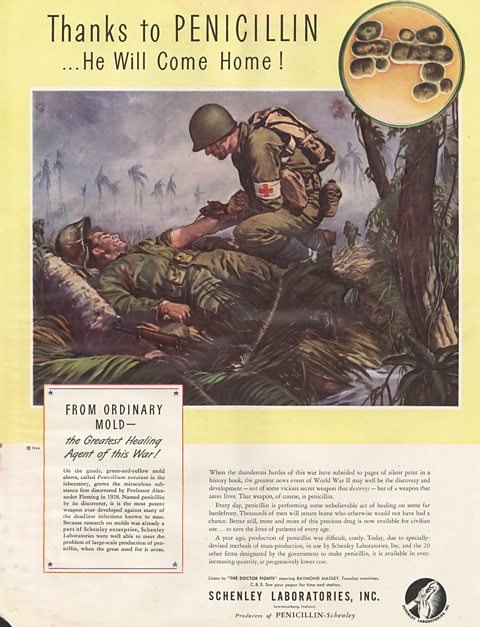 Image source, ALAMY
Image source, ALAMYFlemingâs work was picked up by the Oxford-based scientists Howard Florey and Ernst Chain. Funded by a US grant, they began investigating the effectiveness of penicillin on humans.
They grew their own penicillin in hundreds of hospital bedpans and, by 1941, they were able to begin testing on a human.
Their volunteer was Albert Alexander, who was suffering from sepsisPoisoning of the blood caused by bacterial infection. Formerly known as septicemia..
Albert began to recover. However, Florey and Chain ran out of penicillin five days into the trial and Albert died from his infection.
Florey and Chain determined that it would take 2000 litres of penicillin to treat one infection â producing such quantities was extremely hard to do.
Since the start of World War Two in 1939, British factories were focused on producing armaments and were unable to help with the mass production of penicillin.
But when America entered the war in 1941, the American Government provided interest-free loans for American companies to buy the expensive equipment needed to mass produce penicillin.
By June 1944, with the mass production of penicillin in both America and Britain, the Allied Forces had 2.3 million doses of penicillin â just in time for the D-Day landings that would mark a turning point in the war.
 Image source, ALAMY
Image source, ALAMYPost WW2 healthcare
 Image source, ALAMY
Image source, ALAMYAs World War Two drew to a close and peace began to return to Europe, Britain began to think about how to rebuild the nation since years of war had left many people injured or sick.
In 1945 Britain held a General Election. Winston Churchillâs Conservative Party was defeated, with the Labour Party, under the leadership of Clement Atlee, forming a majority government.
One of the Labour Partyâs key election promises was to implement the findings of the 1942 Beveridge Report and create a society that looked after its citizens from the âcradle to the graveâ.
 Image source, ALAMY
Image source, ALAMYThe creation of the NHS
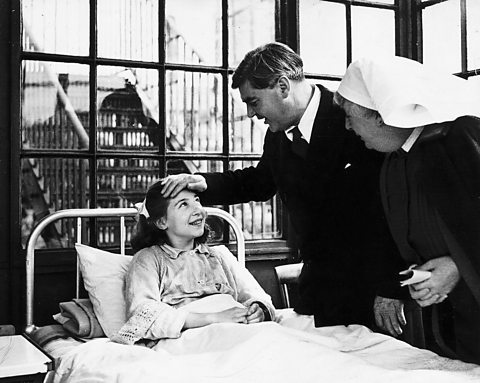 Image source, ALAMY
Image source, ALAMYIn 1948, the Labour Government revolutionised healthcare in Britain with the opening of the National Health Service.
For the first time ever in Britain, all of its citizens were able to receive free health care, at the point of contact.
The Health Minister, Aneurin Bevan, said that to âWorry about money in a time of sickness is a serious hindrance to recovery, apart from its unnecessary cruelty.â
The creation of the NHS allowed the British people to receive the best treatment available. This increased the health and life expectancy of the population significantly.
As the NHS was government funded, this allowed for investments to be made, leading to new hospitals being built and equipped with the latest in technology.
 Image source, ALAMY
Image source, ALAMYTest your knowledge
More on Medicine through time
Find out more by working through a topic
- count1 of 8
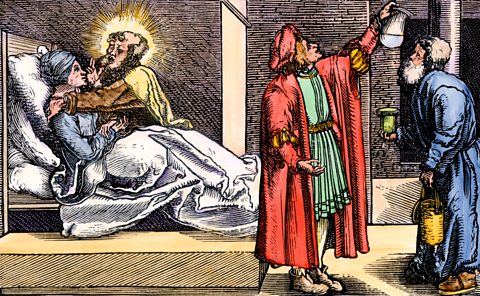
- count2 of 8
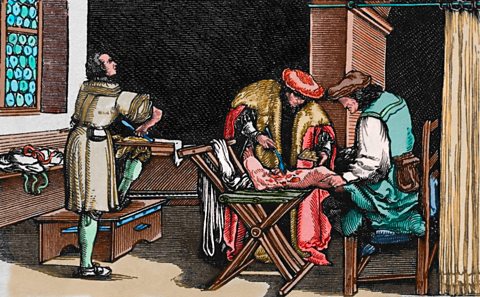
- count4 of 8
